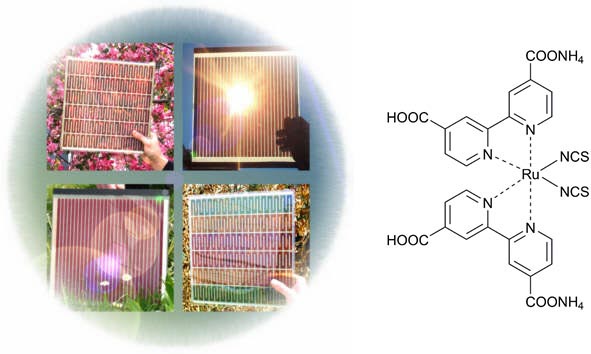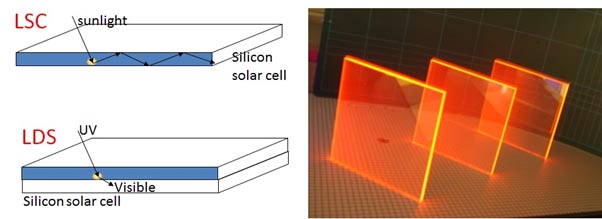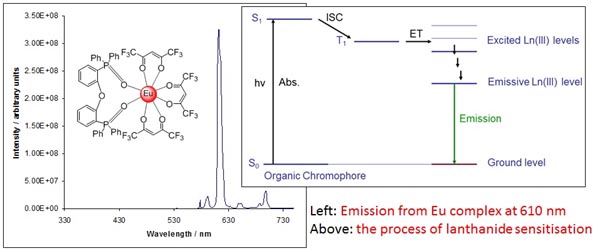Solar energy is by far the largest potential source of renewable energy, the development of which becomes ever more pressing with increasing demand for clean sustainable energy. Photovoltaics, converting light to electricity, is mainly achieved at present with silicon solar cells and also some thin film technologies such as Cadmium Telluride (CdTe). Our research is on the next generation of emerging photovoltaics that can be printed from solution, which offers the possibility for very low-cost, light-weight, flexible, coloured, semi-transparent and portable solar cells. At present however, these don't match the efficiency and long-term stability of Silicon or CdTe solar cells. Research is therefore still needed to realise their full potential and open up new markets and applications not addressed by the current technologies. In this context, our work is mainly on perovskite and dye-sensitised solar cells as outlined below.

Figure 1 Possible scaled up dye-sensitised solar cell modules fabricated in other labs (left), a commonly used standard dye N719 (right).
Perovskite Solar Cells have emerged in the last few years as an exciting new type of photovoltaic that uniquely combines high efficiency with the ability to be printed from solution. This has led to a huge world-wide interest in the field and rapid progress towards commercialisation. Our focus is on new conducting materials (hole-transport materials and electron-transport materials) designed for these cells to help improve efficiency and stability while also reducing cost of the materials. We are also working on new light absorbing materials to broaden the possibilities for future cell design.
Dye-sensitised Solar Cells are based on attachment of a coloured dye to a mesoporous metal oxide such as TiO2. This allows the low-cost, non-toxic, stable semiconductor TiO2 to absorb and use visible sunlight. These cells are being commercialised by several companies, however further improvement in efficiency and stability is still sought to open up wider applications. We work on the design, synthesis and characterisation of new dyes to allow construction of solar cells with better light-harvesting and stability, and also on new conducting (hole-transport) materials for better cell stability.
In both of the above areas, we characterise new molecules and materials using techniques including electrochemistry, absorption and emission spectroscopy, spectroelectrochemistry, computational methods, X-ray diffraction and scanning microscopies. We then use the materials to prepare perovskite and dye-sensitised solar cells in our lab and characterise these using standard techniques such as current-voltage measurement and impedance spectroscopy. We collaborate with physicists and engineers in the UK and internationally for further detailed device characterisation and testing where appropriate.
We also study Luminescent Materials to manipulate the solar spectrum before it reaches a solar cell, to improve the efficiency or open up new application possibilities for solar energy.
A luminescent solar concentrator (LSC) comprises a thin plastic sheet embedded with fluorescent dyes. The dyes absorb incoming sunlight and re-emit light at a longer wavelength. The re-emitted light is mostly trapped in the sheet by total internal reflection and is guided to the edges of the sheet. This allows solar cells, typically based on silicon, to be placed around the edge of the sheet, greatly reducing the total surface area required and effectively replacing these with a cheap plastic sheet. This approach can also be used for semi-transparent solar windows with a range of different colours. The figure below shows the emission of light from the edge of a PMMA sheet containing an emissive dye prepared in our lab.
Luminescent downshifting (LDS) involves similar plastic sheets positioned across the front of the Si solar cell. In this case, incoming UV light is absorbed and re-emitted in the visible. The solar cell is much more responsive to visible light and so the efficiency is increased.

Lanthanide complexes can absorb light through the presence of chromophoric ligands. The excited ligand can then transfer energy to the lanthanide ion, which in turn emits light of characteristic frequency according to the lanthanide used. We are studying Europium complexes, emitting around 610 nm, for luminescent downshifting and Yb complexes, emitting around 980 nm, for luminescent solar concentrators. We characterise the molecules and materials using absorption and emission spectroscopy, X-ray diffraction and computational methods.


